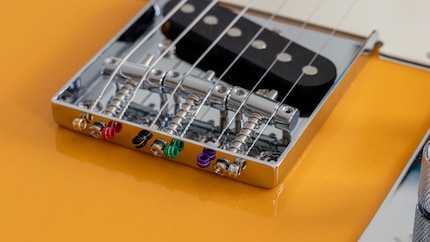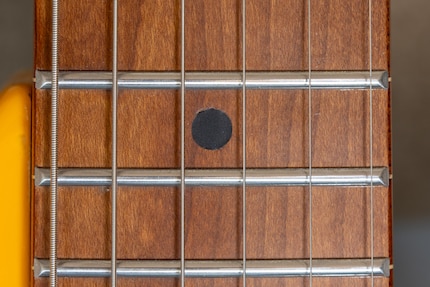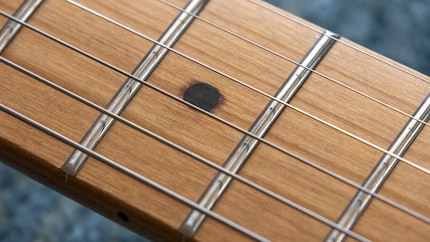
Guide
Picking apart the electric guitar
by David Lee

The Jet JT-300 didn’t make any major mistakes in my test. Considering the price, this wasn’t a foregone conclusion.
The Jet JT-300 is a Telecaster-style guitar. When Leo Fender designed the Telecaster in 1950, he wanted an inexpensive, easy-to-build guitar. A successful endeavour. The Tele is a simple and therefore less error-prone design.
In other words, the Telecaster design is well suited as a template for cheap guitars like the Jet JT-300. It’s pretty hard to mess up, so I was already optimistic before my test that this guitar would prove usable.
In some places you’ll also see the designation T-Style 300 instead of JT-300. In both cases, the T alludes to Telecaster. Jet isn’t allowed to call its guitars this since it’s a protected brand name of the Fender company.
If you’re unfamiliar with certain terms from the world of electric guitars, I recommend this article to get you started:
Many things about the Jet JT-300 remind me of the previously reviewed Jet JS-300. No wonder, it’s from the same brand and series. 300 is the most affordable line from Jet Guitars.
One of those similarities: the guitar looks different when unpacked than in the product pictures. In pictures, the colour of the body resembles the classic butter colour of the Fender Telecaster, i.e. a yellow-beige mixture. In reality, however, the body isn’t at all beige, but a strong, dark yellow.
The neck is much darker than in product pictures, at least on my model. It’s also darker than the previously tested JS-300, although the manufacturer describes both as roasted maple. Could be every model is a bit different. I for one like the yellow-brown colour combination. Otherwise, they’re also available in pink (with a rosewood fingerboard) and sunburst.
My model was put together well, there’s no jiggling anywhere. The guitar holds a note too. This is certainly also thanks to the Tele-like design. The strings run at a favourable angle and there’s no tremolo that could cause problems.
Strings are attached at the bottom of the metal bridge plate. My Fender Telecaster, on the other hand, has holes in the body through which I have to pull the strings. As always, which is better depends on your tastes. I don’t hear or see any drawbacks when the strings are attached directly at the bridge.

As with the JS-300, the frets of the JT-300 are also scratchy. I notice this as I drag a string over the metal to produce an upward gliding sound. Looks like the frets weren’t completely polished. The problem disappears through wear and tear after a few hours, but it’s still irritating at first.
Otherwise, the neck is very good, considering the price of the guitar. Same as with the JS-300. The frets don’t stick out, the neck is easy to play. The strings can be set quite low without buzzing. In contrast to the JS-300, the dots on the fretboard of the JT-300 also look good. My model was already well adjusted when I unpacked it.


The tone control of the JT-300 works as it should. I mention this because it isn’t the case with the JS-300. There, highs only change on the first two levels out of ten, after that hardly anything happens.
The JT-300 also sounds as it should, namely like a Tele. Compared to my Fender American Professional Telecaster, it sounds a bit harsher. It’s surprisingly quiet too, even though the pickups have ceramic magnets. Normally, these pickups tend to be a bit louder than alnico pickups like the ones on my Fender Telecaster.
But I only hear differences when I play the guitar alone without distortion. Distorted and with other instruments, I hardly notice that I’m playing a different guitar in the second half of this recording than in the first. But judge for yourself.
This time I didn’t record with my little practice amp and a field recorder, but used the output of a Line 6 Pod Express directly. Here, I switched between the default settings Clean and Crunch. A separate test will follow for the Pod Express.
But there is one thing that’s much worse than on my original Telecaster: the Jet JT-300 buzzes a lot. My only consolation: in the middle position, with both pickups active, there’s significantly less buzzing. Here’s a direct comparison. Note: this is an extreme example to illustrate the difference. The guitar doesn’t normally buzz this much.
Pro
Contra
My interest in IT and writing landed me in tech journalism early on (2000). I want to know how we can use technology without being used. Outside of the office, I’m a keen musician who makes up for lacking talent with excessive enthusiasm.